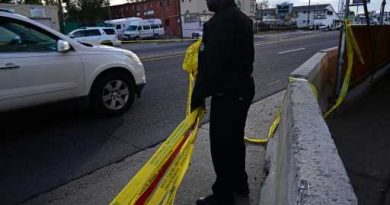Russia’s top secret spy mission aboard Soyuz rocket laid bare
Russia launches rocket on third test flight and misses intended orbit
We use your sign-up to provide content in ways you’ve consented to and to improve our understanding of you. This may include adverts from us and 3rd parties based on our understanding. You can unsubscribe at any time. More info
Record-breaking NASA astronaut Mark Vande Hei is due to return to Earth from the International Space Station on Wednesday aboard a Russian Soyuz rocket with two Russian astronauts. Mr Vande Hei’s return has been an ongoing source of disagreement in recent weeks, as relations between Russia and the US sour after the invasion of Ukraine. Mr Vande Hei’s stay on the ISS was extended in September to accommodate a select few visiting tourists and Russian film crews sent into space at the end of last year.
Things took a turn earlier this month when RIA Novosti, a Russian state broadcaster, shared a satirical video depicting Mr Vande Hei’s Russian colleagues leaving him behind on the ISS.
After RIA Novosti described the video as a joke, Russia formally denied the speculation, saying all three will return as scheduled on March 30.
Mr Vande Hei and his crewmates boarded the Soyuz at around 5am on Wednesday morning, with departure due around 8:20am.
As of last year, the Soyuz is the most frequently used launch vehicle in the world, with over 1,900 flights since its debut in 1966.


The Soyuz was designed for the Soviet space program in the Sixties, and served as the only means to ferry crew to or from the ISS between 2011 and 2020.
Earlier this year, Russia launched a top secret spy mission aboard a Soyuz rocket.
Lift-off of the Soyuz-2.1a rocket occurred at 7am on February 5 from the Plesetsk Cosmodrome.
Plesetsk, located about 500 miles (800 kilometres) north of Moscow, has been used as a launch site for multiple rocket types since the dawn of the space race.

US military tracking data confirmed the successful launch of the Soyuz, indicating that it had reached an unusual orbit more than 1,200 miles (1,931 kilometres) above Earth, an altitude that allows it to circle the planet every 127 minutes.
Russian officials officially named the satellite Kosmos 2553, in line with Moscow’s naming scheme for military spacecraft.
The Kremlin said Kosmos 2553 is “equipped with newly developed on-board instruments”.
Beyond this, however, very little is known.
DON’T MISS:
Russian soldiers in Ukraine panicking: ‘What have we got into’ [EXPERT]
Ukraine: Putin deploys 1,000 strong assassination squad [REPORT]
Putin humiliation as generals hide truth [INSIGHT]

Due to the classified nature of the mission, Everyday Astronaut reports it “cannot be specified” exactly where the satellite went, and nothing is known about the characteristics of the satellite besides the limited information provided by Russia’s defence ministry.
According to Spaceflight Now, analysts believe Kosmos 2553 could be an imaging satellite for the Russian military — particularly pertinent given that Putin invaded Ukraine less than three weeks after the rocket launched.
It had been speculated that it was the first in a new series of radar reconnaissance satellites called Neitron.
Radar satellites are capable of collecting all-weather satellite images during both the day and night.

Neitron had initially been due to launch in late 2018, but this was delayed, reportedly due to technical issues.
Russian forces have launched a number of new satellites in recent years, including Pion-NKS and Lotos satellites — capable of intercepting radio transmissions and helping Russian intelligence locate foreign shipping traffic, including naval forces.
US officials also believe Russian military spacecraft have tested anti-satellite capabilities in orbit.
Russia’s invasion of Ukraine has proved a hammer blow to the country’s space ambitions, however.
Moscow’s space chief Dmitry Rogozin admitted earlier this month that his country will “lose several years” in its bid to put a rover on Mars after the European Space Agency suspended work with Russia on its upcoming ExoMars mission.
Concerns also remain about the ongoing safety of the ISS, given that Russia controls some crucial aspects of the space station’s propulsion control systems, which prevent it from being pulled into the Earth’s atmosphere and slowly burning up.
Despite ongoing concerns, however, ISS crew showed their unity this week ahead of the Soyuz’s scheduled return on Wednesday.
They conducted a change of command ceremony, with former commander Anton Shkaperlov handing over the ropes to NASA astronaut Tom Marshburn.
Mr Shkaperlov hinted at the geopolitical tensions on Earth during the ceremony, saying: “I [am] proud I was the commander of this excellent crew.
“People have problems on Earth. On orbit… we are one crew.”
Source: Read Full Article


